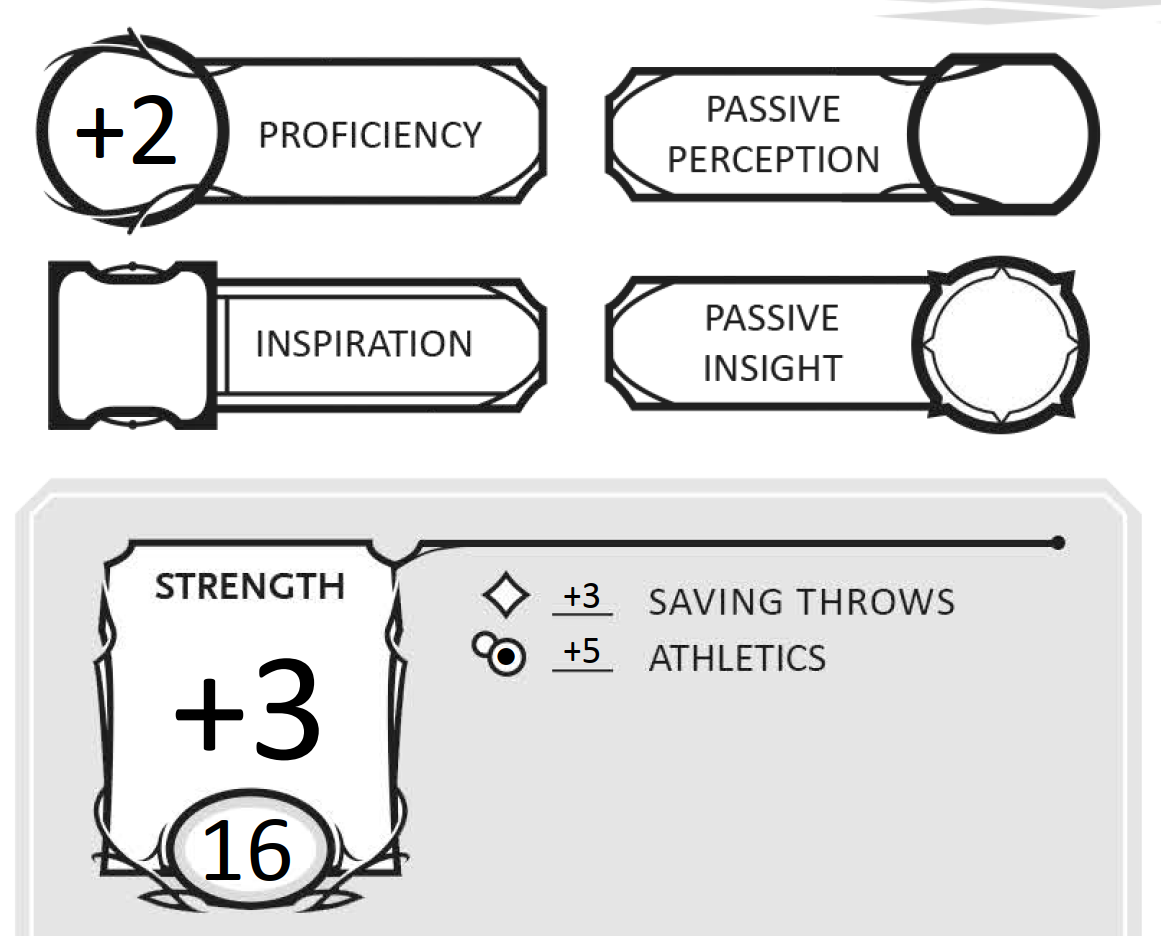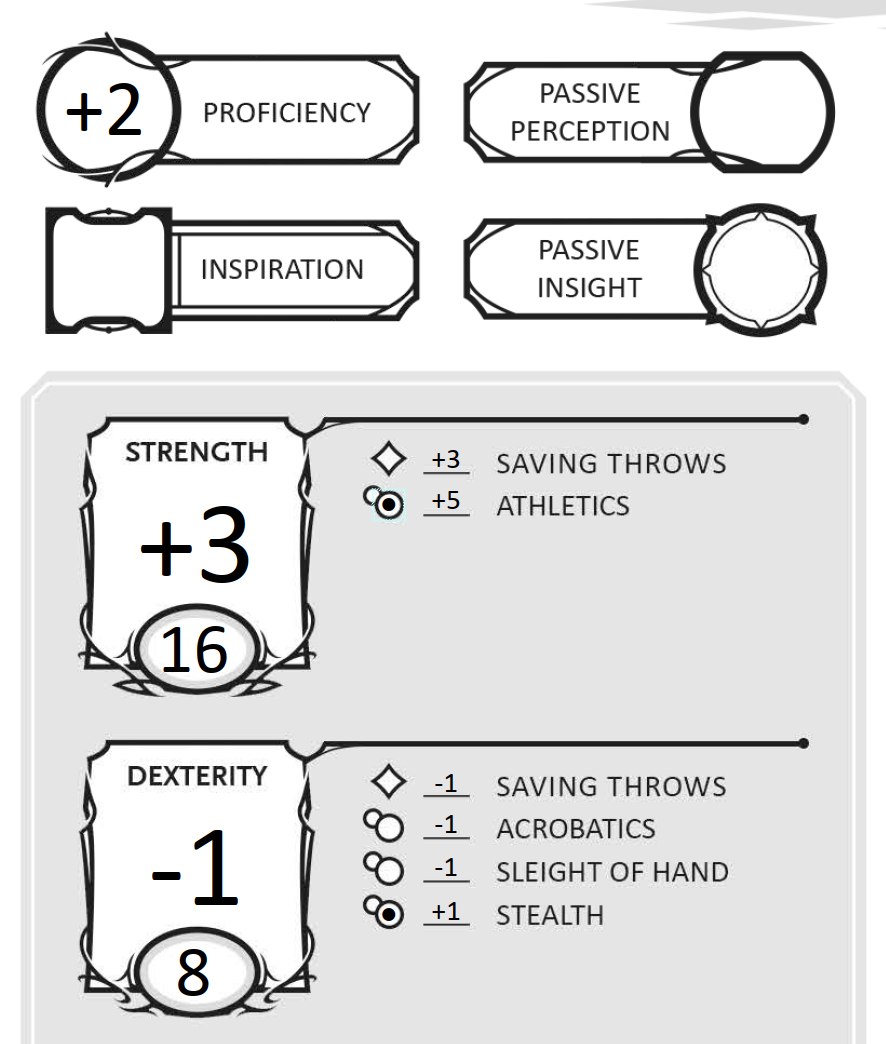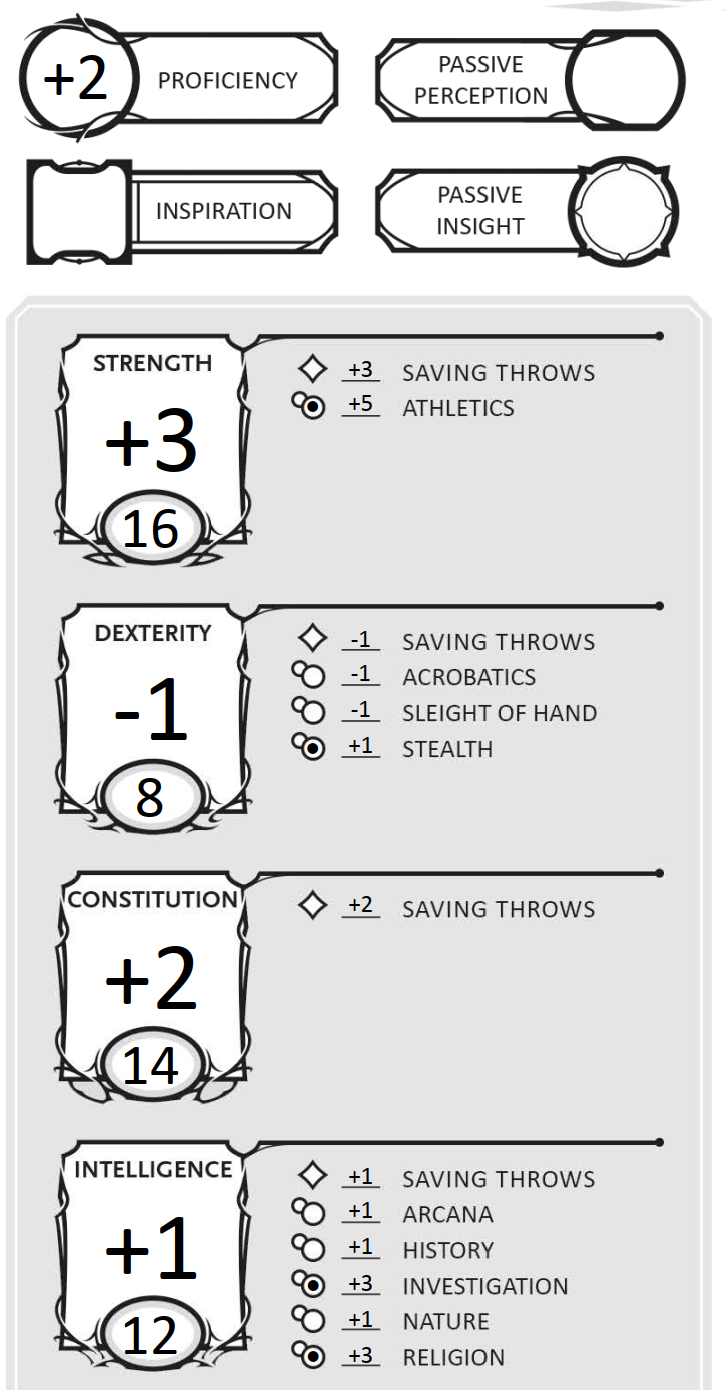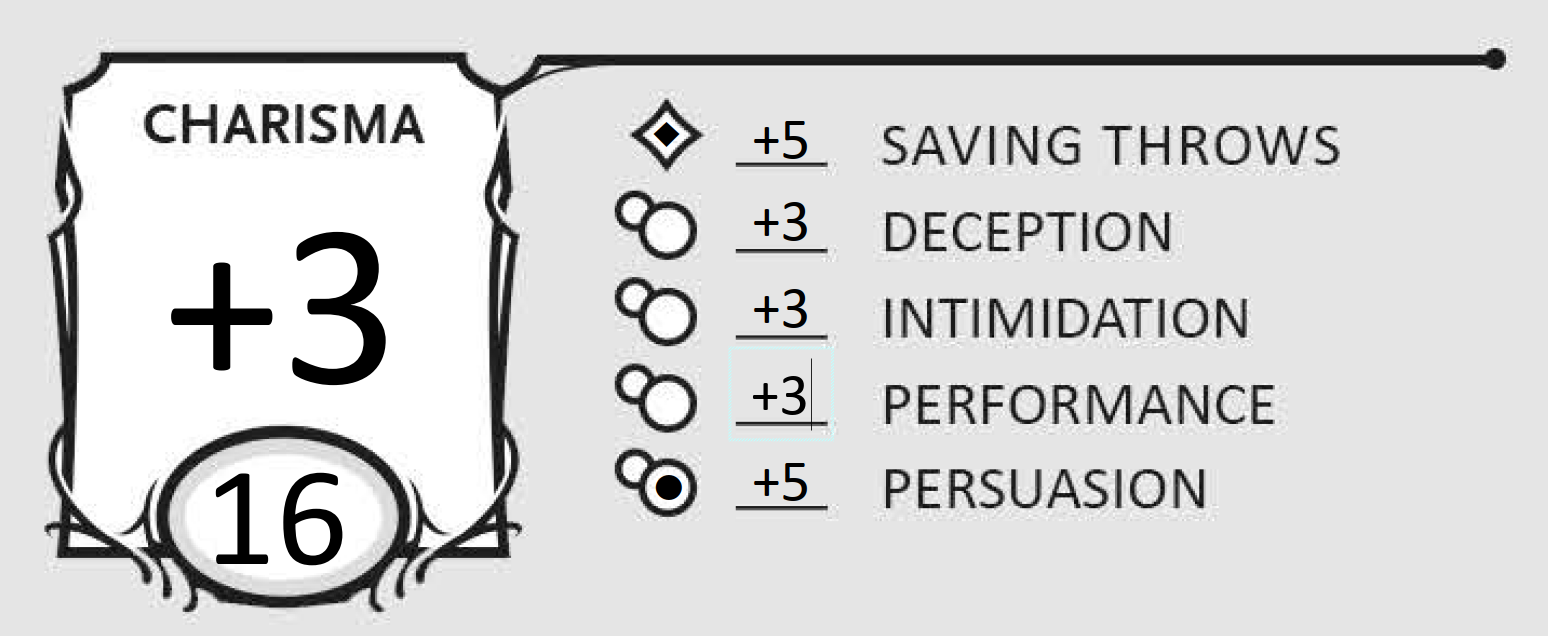D&D
You’re not even straddling a line between a story and a game. It is a perfect wedding of the two. The game matters because it’s attached to a story that you love, and the story matters because it’s a game you’re all playing together. It’s the best thing in the world.
―Brennan Lee Mulligan
Getting into D&D can be a bit intimidating, since the developers’ “basic rules” are 180 pages long and generally serve as a reference document rather than something to be read cover-to-cover.
I’ll try to explain the basics as concisely as possible (and will miss some details), but honestly the best way to learn is to watch a play show like Dimension 20 or to just go play some D&D!
Dice
If there’s a chance of a better or worse outcome in D&D, you’re going to roll some dice. There are six common sizes of dice: d20, d12, d10, d8, d6, and d4. The number is the number of sides. Sometimes you’ll need to roll multiple dice, like 3d6 (rolling 3 six-side dice), or roll multiple sizes of dice, like 1d10 + 2d8.
How not to roll a d4.
Rolling to Determine Success
Generally, rolling to determine success/failure in D&D goes something like this:
- The DM asks for a particular skill/ability check.
- You roll a d20.
- Add the relevant ability modifier.
- Add your proficiency bonus (PB), if you’re proficient with the relevant skill/item.
- Tell your DM the total, and they’ll tell you if you succeed.

For example, say the above is part of your character sheet and the DM asks you for a Strength (Athletics) check to jump across a wide gap. The fast answer is to roll a d20 and add 5, since that’s the modifier for “ATHLETICS” under “STRENGTH”. But why is it +5?
The relevant ability is Strength, and your modifier is +3 (the number under “STRENGTH” with the + or - next to it). The bubble next to Athletics indicates that you’re proficient in it, so you add your proficiency bonus (+2). +5 is the total, and is written next to Athletics for convenience since Strength is the most common ability for Athletics. You can assume that an “Athletics check” refers to Strength unless told otherwise.
Difficulty Class
How does the DM determine if your roll is high enough? Before you make the roll, they set a Difficulty Class or DC and may or may not tell you what it is. If your roll matches the DC or exceeds it, you succeed! If not, well…
Nat 20s and Nat 1s
Rolling a nat 20 (where the d20 roll itself comes up on the 20 face) can result in greater success than simply achieving the DC. A nat 1 (rolling a 1 on the die) can create a result worse than expected.
In the D&D 5e ruleset, nat 20s and nat 1s only affect attack rolls and death saving throws. A common house rule is to make them apply to other d20 rolls as well, like seeing almost-imperceptible details on a nat 20 Perception check or faceplanting on a nat 1 Acrobatics check.
Brennan: “Truly, the only cursed human being I know in real life, we were talking about it earlier.”
Murph: “So bad at rolling dice.”
Advantage and Disadvantage
This is a mechanic that only applies to rolls involving a d20. If told to roll with advantage, roll 2d20 and take the higher result. Disadvantage means rolling 2d20 and taking the lower result.
Abilities and Skills
Ability Checks and Saving Throws
I covered an example of an ability check already, but there are still a few things to clarify. A DM might ask for an “Ability (Skill) check” like a “Dexterity (Stealth) check,” or they could just ask for a “Stealth check” for short - since Stealth is associated with Dexterity by default. So if the below section is part of your character sheet, a “Stealth check” would involve rolling a d20, subtracting 1 for your DEX modifier, and adding 2 (your proficiency bonus) since you’re proficient in stealth (the bubble is filled in). So the overall formula is d20 + 1, which is why “Stealth” has a +1 next to it.

However, This doesn’t stop the DM from switching things up and asking for a non-default ability instead. An Intelligence (Stealth) check might involve using prior knowledge of alternate entrances, exits, and routes in a building in order to sneak around unnoticed. You would roll a d20, add your Intelligence modifier, then add your proficiency bonus if you’re proficient in Stealth. For example:

If the DM asks for an Intelligence (Stealth) check and your stats look like the above image, you roll a d20, add +1 (your Intelligence modifier), then add another +2 from your proficiency bonus since you’re proficient in stealth (again, the filled in bubble next to “Stealth”). So the total formula is d20 + 3.
A flat ability check means that only an ability (and no skill) is associated with the roll - so a “flat Charisma check” is just rolling a d20 and adding your Charisma modifier.
A saving throw is a skill check made in response to some event occurring. If Fireball is cast at a character, they will make a Dexterity saving throw to try to reduce the damage taken. Similar to any other skill check, you roll a d20, add the ability modifier, and add proficiency bonus if you’re proficient in that saving throw (marked by a filled-in bubble on your character sheet, similar to skills).

Hopefully this helps the random +1s and +3s make more sense!
Ability Descriptions
There are six main stats (ability scores) for your character, represented by the six large boxes on your character sheet.
Strength
STR (strength) is physical power. It increases carrying capacity and the effectiveness of most melee weapons, and lets you use the heaviest armors. STR checks often involve short-term high-exertion activities - running, jumping, breaking things, etc. It’s a common primary stat for martial classes like the paladin.
Dexterity
DEX (dexterity) is agility. It increases initiative, armor class if wearing no/light/medium armor, and the amount of damage done by ranged weapons (like crossbows) and Finesse weapons (like rapiers and daggers). DEX checks include sneaking, dodging, and pickpocketing. Generally a very useful stat to have.
Constitution
CON (constitution) is stamina and vitality. It increases max HP and how easily a spellcaster can maintain concentration on certain spells. CON checks include holding one’s breath, maintaining physical/mental health with limited rest, and generally anything that taxes a character over a period of time. A good stat on all characters to increase HP.
Intelligence
INT (intelligence) is book-smarts and logic, and the spellcasting stat for wizards/artificers. INT checks include making deductions based on clues and recalling information. Common dump stat for anybody not playing a wizard or artificer.
Wisdom
WIS (wisdom) is gut instincts and intuition, and the spellcasting stat of clerics/druids/rangers. WIS checks include noticing small details, picking up on subtle clues in body language, and administering medical aid. A good stat, since perception and insight are always useful.
Charisma
CHA (charisma) is social prowess and how easily a character gets along with NPCs. It’s the spellcasting stat of bards, paladins, sorcerers, and warlocks. CHA checks include deceiving, intimidating, and persuading NPCs.
Ability scores and modifiers
Ability scores range from 1-20. Higher is better, since higher scores mean higher ability modifiers (ranging from -5 to +5), which yield rolls which can frequently pass high DC challenges. An average non-adventurer has 10 in all stats, which is +0 to all rolls.
| Score | 1 | 2-3 | 4-5 | 6-7 | 8-9 | 10-11 | 12-13 | 14-15 | 16-17 | 18-19 | 20 |
|---|---|---|---|---|---|---|---|---|---|---|---|
| Modifier | -5 | -4 | -3 | -2 | -1 | +0 | +1 | +2 | +3 | +4 | +5 |
Basically, every even number above 10 you get another +1 to your dice rolls involving that stat. Every odd number below 9, you get another -1.
Proficiency
Characters are proficient in certain skills, saving throws, and tools based on class, background, and race. These are represented by filled-in bubbles/diamonds on the left side of your character sheet.
If you are making a check that you are proficient in, you get to add your proficiency bonus (PB) to your roll (in addition to the relevant stat, if applicable).
| Level | 1-4 | 5-8 | 9-12 | 13-16 | 17-20 |
|---|---|---|---|---|---|
| Prof. Bonus | +2 | +3 | +4 | +5 | +6 |
Combat
When combat starts, the DM will tell the party to roll initiative, which represents how soon a character can act in combat. To roll initiative, roll a d20 and add your DEX modifier.
Armor Class
AC represents how hard a character is to hit. Armor is light, medium, or heavy, and your armor proficiencies are generally determined by your class. (Wearing armor without proficiency has some penalties.)
Some armor properties can be found below, and the full properties can be found on Roll20. Armor marked with an asterisk (*) gives you disadvantage on all Dexterity (Stealth) checks while you wear it.
D&D 5e also has shields, which add a flat +2 to your AC while equipped.
| Armor | Category | Your AC |
|---|---|---|
| Unarmored | N/A | 10 + DEX |
| Padded* | Light | 11 + DEX |
| Leather | Light | 11 + DEX |
| Studded leather | Light | 12 + DEX |
| Hide | Medium | 12 + min(DEX, 2) |
| Chain shirt | Medium | 13 + min(DEX, 2) |
| Scale mail* | Medium | 14 + min(DEX, 2) |
| Breastplate | Medium | 14 + min(DEX, 2) |
| Half plate* | Medium | 15 + min(DEX, 2) |
| Ring mail* | Heavy | 14 |
| Chain mail* | Heavy | 16 |
| Splint* | Heavy | 17 |
| Plate* | Heavy | 18 |
Attacking
To hit someone with a weapon, you make an attack roll to see if you hit - it has to match or exceed the enemy’s AC to hit. Roll a d20, add the relevant stat (STR for most melee weapons, DEX for most ranged weapons), and add your proficiency bonus if you’re proficient with the weapon. A nat 20 is a crit (you’re guaranteed to hit and do additional damage), and a nat 1 will always miss.
If you hit, you make a damage roll to see how much damage your attack did. Roll the damage dice for your weapon and add the relevant ability score, but not your proficiency.
Attack Roll Examples
Here’s a video example, followed by a text example.
For a text-based example, let’s say a fighter with 16 AC, +3 STR, and +1 DEX is fighting an imp with 13 AC.
Player: “I want to try to hit this imp in front of me with my greatsword.”
DM: “Great, roll to hit.”
Player: “That’s a 10 [on the d20], plus 3 strength, plus 2 proficiency is a 15.”
DM: “That hits! Roll damage.”
Player: “Alright, the greatsword is 2d6…I rolled a 7, plus 3 strength is 10 damage.”
DM: “Great! The imp’s not looking good - anything else on your turn?”
Player: “Nope.”
DM: “Alright, the imp is going to make an attack…does a 14 hit?”
Player: “No, my AC is 16.”
Death Saving Throws
Player characters and some NPCs fall unconscious upon reaching 0 HP. Each subsequent turn, the character must roll a death saving throw. A 10 or higher is a success, and a 9 or lower is a failure (and any bonuses that apply to “all saving throws” apply).
Get three cumulative successes before three cumulative failures, and a character becomes stable - they don’t have to make more saving throws, but stay unconscious until brought above 0 HP. Also, an adjacent friendly character can make a DC 10 Medicine check to stabilize the dying character. Three failures means the character dies.
Death saving throws reset once the character becomes stable or conscious, and healing will instantly return a character to consciousness.
A nat 20 instantly returns the character to consciousness with 1 HP. A nat 1 counts as 2 failures. Getting hit while unconscious counts as a failed death saving throw.
Your Turn
When taking a turn in combat, you get movement, an action, and possibly a bonus action. You also get one reaction every round. This is a great online cheatsheet that tells you what you can do on your turn.
Movement
You can move up to the distance stated on your character sheet. 1 square in any direction (including diagonals) is 5 feet. You can spread this movement out throughout your turn if you want.
You can also take cover for free if there’s something convenient nearby. Half cover (which covers about half of your body) gives +2 to AC and DEX saves, and 3/4 cover gives a +5 bonus. If totally covered, you can’t be directly targeted by attacks/spells.
Action
An action can be used to:
-
Attack with one weapon
-
Cast a spell, if the casting time is “1 action”
-
Dash: Double your movement
-
Dodge: Enemies’ attacks have disadvantage to hit, and you have advantage on DEX saving throws until your next turn
-
Disengage: Enemies cannot take opportunity attacks as you move out of their range
-
Help: either
- Help an ally with a task, giving them advantage on the relevant ability check on their turn, or
- Help an ally attack a creature within 5 feet of you, giving your ally advantage on their first attack against that enemy on their turn.
-
Hide (Make a stealth check against enemies’ perception. If you pass, they don’t know where you are)
-
Ready (Define a condition and an action. If the condition occurs, you execute the action as your character’s reaction. If the condition doesn’t happen, the action isn’t triggered)
Bonus Action
You can only take a bonus action if something on your character sheet requires a bonus action - a spell, class feature, or something like that.
Reaction
You can use a reaction to cast a spell with a casting time of a reaction (like Shield), use a readied action, or make an attack of opportunity:
When character A leaves the controlled area of a hostile character B (all squares that B can reach with its equipped weapon), B can use its reaction to make a melee attack on A before A moves. This is called an attack of opportunity, or an opportunity attack.
Spellcasting
Some classes have access to spells, which can have powerful effects in both combat and RP. Spells are either cantrips which don’t consume spell slots (see below), or they are leveled spells (unofficial term) which require spell slots. All information on a spell - its effects, level, range, duration, etc. can be found online at a website like D&D Beyond.
How to destroy your DM’s carefully planned encounter with spells.
Spell Slots
Spell slots limit how many powerful spells a caster can use in a day. Spell slots and leveled spells have an associated level from 1 to 9, with higher levels being more powerful. As a caster levels up, they get access to more spell slots, higher-level spell slots, and higher-level spells.
Spells require an equal or higher level spell slot to cast. Let’s say you want to cast Fireball, which is a level 3 spell. You can choose to use a 3rd-level spell slot, which will deal 8d6 damage in a 20-foot radius, or if you have 4th-level slots (or higher), you can upcast the spell and use one of those higher-level slots instead, increasing the damage dealt by 1d6 for each level above 3rd.
Spell Attack Bonus and Save DC
Targeting an enemy with a spell will either prompt you to make a spell attack or prompt the enemy to make a saving throw.
If you’re making a spell attack, you’ll make an attack roll, but your bonus to hit (your spell attack bonus) is equal to (your spellcasting stat + your proficiency).
So using more or less the same logic we’ve used everywhere else, let’s do an example with a level 5 wizard with 18 INT (+5 proficiency, +4 spellcasting stat). To cast Fire Bolt, they roll a d20, add 7, and check if the result beats the enemy’s AC. If it hits, they’ll deal 1d10 fire damage. Generally, spells will not add the spellcasting stat to damage, unlike weapons.
If your spell forces the enemy to make a saving throw, the DC of that enemy’s saving throw (your spell save DC) is (8 + proficiency + spellcasting stat). So if that same wizard casts fireball, the enemy has to beat a DC 15 DEX saving throw - if they succeed, the damage is halved.
